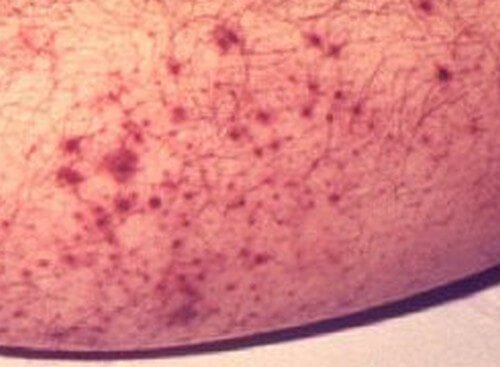Petechiae Definition
Petechia is actually a spot on your skin that may be red to purple in color.
Petechiae is the plural form when there are groups of spots appearing on the skin. These are results of minor hemorrhage. They may appear like a rash and usually emerge in clusters. These spots appear on the skin particularly of legs.
Petechiae are at most instant harmless. They disappear on their own after a few days.
Causes of Petechiae
Petechiae is a sign of a disease related to low platelet count (thrombocytopenia). It can also occur if extreme pressure is applied to the tissues such as in excessive vomiting, tourniquet application or in too much coughing.
They can occur among the children and the most common cause for them is viral infection. But sometimes, this can be a result of some grave conditions such as leukemia or meningococcemia. They require an instant support from the doctors.
Non-Infectious Causes of Petechiae
Non-infectious causes in which petechiae occur include:
- Idiopathic thrombocytopenic purpura
- Celiac Disease
- Hypocalcemia
- Kawasaki disease
- Aplastic anemia
- Erythroblastosis fetalis
- Leukemia
- Lupus
- Schamberg’s disease
- Scurvy
- Kwashiorkor
- Vitamin K deficiency
- Marasmus
- Ehlers–Danlos syndrome
- Henoch-Schönlein purpura (HSP)
Infectious Causes of Petechiae
There are a number of infections caused by either bacteria or virus that lead to petechiae formation. These include:
- Dengue fever
- Cerebral malaria
- Bolivian hemorrhagic fever
- Congenital syphilis
- Boutonneuse fever
- Dukes’ disease
- Cytomegalovirus
- Endocarditis
- Crimean–Congo hemorrhagic fever
- Ebola
- Influenza A virus subtype H1N1
- Infectious mononucleosis
- Hantavirus
- Neisseria meningitidis
- Marburg virus
- Rocky Mountain spotted fever
- Typhus
- Scarlet fever
Drugs that Cause Petechiae
Petechiae formation may also happen as an adverse effect of certain drugs such as:
- Warfarin
- Naproxen
- Heparin
- Cimetidine
- Penicillin
- Cortisone
- Carbamazepine
- Aspirin
Chemotherapy and radiation may also lead to its development in certain circumstances.
Other Causes
Asphyxiation is can also be a cause of petechiae appearance. Petechiae formation on the soft palate is chiefly linked with pharyngitis by a streptococcal infection. Hard bouts of coughing can lead to appearance of petechiae on the face particularly around the eyes. Allergic reactions due to medications may give rise to petechiae formation and this occurs in response to the body’s reaction.
Symptoms of Petechiae
Well, symptoms depend on the underlying condition in addition to this petechial spots or rash. Infectious conditions are accompanied by fever, malaise, and flu-like symptoms. There are some other manifestations of the particular system involved by the infection.
The petechiae initially is red in colour. It appears in the form of individual blotches in the preliminary stages. With the passage of time, they coalescence together and then appear as a rash. The petechiae are flat spots that change their colour as the time passes.
It is a must that you see your health care practitioner promptly in case you or a family member develops petechia. It’s vital to establish the cause, given that some underlying setbacks can be potentially grave.
Special Characteristics of Petechiae
There are certain features specific to petechiae that help their earlier detection and differentiate them from other rashes and spots.
Size of Petechiae
The size of petechiae is not more than a 3mm. These are the tiny hemorrhagic spots. These are usually 0.5 to 1 mm in diameter. Larger form of petechiae measuring greater than 3 mm is termed as purpura.
Location of Petechiae
Petechiae can appear anywhere on our body but the particular area where it is commonly seen include the legs, face, ankles, back, thigh and shoulders.
Colour of the Petechiae
Usually the initial colour of the petechiae is red. It appears in the form of a rash. Then it turns to bluish or purplish. Ultimately, its colour turns to dark purple or blue.
Never Fade on Pressure
The characteristic feature of the petechiae is that if they are pressed by applying pressure they never fade i.e. their colour does not lighten.
Petechiae Pictures

Picture 1 : Difference between purpura and petechiae
Image source : lowplatelets

Picture 2 : Petechiae on medial aspect of the leg
Image source : calicutmedicaljournal

Picture 3 : Petechiae on lower legs

Picture 4 : Petechiae photos
Image source : iknow2.net
Differential Diagnosis of Petechiae
Diagnosis of petechiae starts with the patient’s history and his/her physical examination. Blood tests are usually carried out, including:
- Complete blood count (CBC)
- Platelet count
- Bleeding time
- Prothrombin time
- Partial thromboplastin time
These tests are necessary and usually ordered to differentiate it from different other causes such as:
- Hypersensitivity angiitis
- Purpura
- Scurvy
- Rickettsial spots
- Thrombocytopenia
- Wiskott-Aldrich syndrome
Petechiae vs Purpura vs Ecchymoses
- Small lesions (<3 mm) are called Petechiae
- Intermediate size lesions (3 mm to 5 mm) are called Purpura
- Larger lesions (>5 mm) are called Ecchymoses.
Treatment of Petechiae
The first and foremost way of managing this condition is to correct the underlying cause. If it is corrected, it will automatically correct the condition of the petechiae formation. Other ways to treat petechiae are given below:
Leave The Causative Agent – Medicine
It is necessary to identify the agent causing these petechiae. If it is due to a drug because of an allergic reaction produced by that particular drug, then immediately discontinue taking this medicine. It is the simplest way to treat them. It is must to see a doctor in this situation as well.
Antibiotics
Antibiotics are prescribed in case of an infection causing petechia formation and appearance. This way, not only petechiae will be treated but also, the infection will get eradicated as well.
Application of Ice or Cold Compression
If these petechiea spots are the consequence of injuries to the blood capillaries, then apply ice packs or cold compressions over the affected region. This alleviates the condition. It is suggested that before applying an ice, a paper towel should be put between your skin and the ice pack. This will prevent damage to the skin surface.
Platelet Transfusion
This is recommended in case petechiae are occurring as a result of low platelet count. Platelet transfusion may might just solve the problem.
Surgical Option
Surgery is not necessary for patients with petechiae. If petechiae are due to leukemia or any other malignant conditions, then surgery may be needed to offer a good management. Though the reason for surgery will be because of the very serious condition itself, not because of the petechiae.
References:
- http://www.mayoclinic.com/health/petechiae/MY01104
- http://en.wikipedia.org/wiki/
Petechia - http://www.nhlbi.nih.gov/
health//dci/Diseases/thcp/ thcp_signs.html - http://symptom.healthline.com/
symptomsearch?addterm= Petechiae - http://www.dermatology.ucsf.edu/education_training/140.01ClinicalDermatology/MODULES%20UCSF/Petechia%20Purpura%20Vasculitis.pdf
